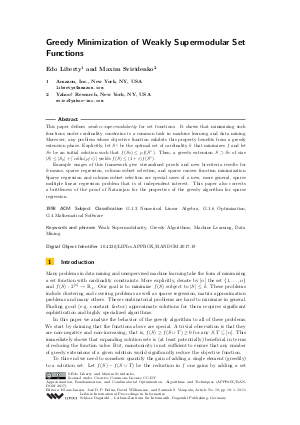Greedy Minimization of Weakly Supermodular Set Functions
Authors Edo Liberty, Maxim Sviridenko
-
Part of:
Volume:
Approximation, Randomization, and Combinatorial Optimization. Algorithms and Techniques (APPROX/RANDOM 2017)
Part of: Series: Leibniz International Proceedings in Informatics (LIPIcs)
Part of: Conference: International Conference on Randomization and Computation (RANDOM)
Part of: Conference: International Conference on Approximation Algorithms for Combinatorial Optimization Problems (APPROX) - License:
 Creative Commons Attribution 3.0 Unported license
Creative Commons Attribution 3.0 Unported license
- Publication Date: 2017-08-11
File

PDF
LIPIcs.APPROX-RANDOM.2017.19.pdf
- Filesize: 426 kB
- 11 pages
Document Identifiers
Subject Classification
Keywords
- Weak Supermodularity
- Greedy Algorithms
- Machine Learning
- Data Mining
Metrics
- Access Statistics
-
Total Accesses (updated on a weekly basis)
0Document
0Metadata
Abstract
Many problems in data mining and unsupervised machine learning take the form of minimizing a set function with cardinality constraints. More explicitly, denote by [n] the set {1,...,n} and let f(S) be a function from 2^[n] to R+. Our goal is to minimize f(S) subject to |S| <= k. These problems include clustering and covering problems as well as sparse regression, matrix approximation problems and many others. These combinatorial problems are hard to minimize in general. Finding good (e.g. constant factor) approximate solutions for them requires significant sophistication and highly specialized algorithms.
In this paper we analyze the behavior of the greedy algorithm to all of these problems. We start by claiming that the functions above are special. A trivial observation is that they are non-negative and non-increasing, that is, f(S) >= f(union(S,T)) >= 0 for any S and T. This immediately shows that expanding solution sets is (at least potentially) beneficial in terms of reducing the function value. But, monotonicity is not sufficient to ensure that any number of greedy extensions of a given solution would significantly reduce the objective function.
Cite As Get BibTex
Edo Liberty and Maxim Sviridenko. Greedy Minimization of Weakly Supermodular Set Functions. In Approximation, Randomization, and Combinatorial Optimization. Algorithms and Techniques (APPROX/RANDOM 2017). Leibniz International Proceedings in Informatics (LIPIcs), Volume 81, pp. 19:1-19:11, Schloss Dagstuhl – Leibniz-Zentrum für Informatik (2017)
https://doi.org/10.4230/LIPIcs.APPROX-RANDOM.2017.19
BibTex
@InProceedings{liberty_et_al:LIPIcs.APPROX-RANDOM.2017.19,
author = {Liberty, Edo and Sviridenko, Maxim},
title = {{Greedy Minimization of Weakly Supermodular Set Functions}},
booktitle = {Approximation, Randomization, and Combinatorial Optimization. Algorithms and Techniques (APPROX/RANDOM 2017)},
pages = {19:1--19:11},
series = {Leibniz International Proceedings in Informatics (LIPIcs)},
ISBN = {978-3-95977-044-6},
ISSN = {1868-8969},
year = {2017},
volume = {81},
editor = {Jansen, Klaus and Rolim, Jos\'{e} D. P. and Williamson, David P. and Vempala, Santosh S.},
publisher = {Schloss Dagstuhl -- Leibniz-Zentrum f{\"u}r Informatik},
address = {Dagstuhl, Germany},
URL = {https://drops.dagstuhl.de/entities/document/10.4230/LIPIcs.APPROX-RANDOM.2017.19},
URN = {urn:nbn:de:0030-drops-75682},
doi = {10.4230/LIPIcs.APPROX-RANDOM.2017.19},
annote = {Keywords: Weak Supermodularity, Greedy Algorithms, Machine Learning, Data Mining}
}
Author Details
References
- Ankit Aggarwal, Amit Deshpande, and Ravi Kannan. Adaptive sampling for k-means clustering. In Approximation, Randomization, and Combinatorial Optimization. Algorithms and Techniques, 12th International Workshop, APPROX 2009, and 13th International Workshop, RANDOM 2009, Berkeley, CA, USA, August 21-23, 2009. Proceedings, pages 15-28, 2009. URL: http://dx.doi.org/10.1007/978-3-642-03685-9_2.
-
David Arthur and Sergei Vassilvitskii. k-means++: the advantages of careful seeding. In SODA, pages 1027-1035, 2007.

-
C. Boutsidis, P. Drineas, and M. Magdon-Ismail. Near-optimal column-based matrix reconstruction. SIAM Journal on Computing, 43(2):687-717, 2014.

-
T. F. Chan and P. C. Hansen. Some applications of the rank revealing qr factorization. SIAM Journal on Scientific and Statistical Computing, 13:727, 1992.

-
A. Das and D. Kempe. Submodular meets spectral: Greedy algorithms for subset selection, sparse approximation and dictionary selection. In In Proceedings of ICML, pages 1057-1064, 2011.

-
A. Deshpande and L. Rademacher. Efficient volume sampling for row/column subset selection. In Proceedings of the 42th Annual ACM Symposium on Theory of Computing (STOC), 2010.

-
Amit Deshpande, Luis Rademacher, Santosh Vempala, and Grant Wang. Matrix approximation and projective clustering via volume sampling. Theory of Computing, 2:225-247, 2006.

- Dan Feldman, Amos Fiat, Micha Sharir, and Danny Segev. Bi-criteria linear-time approximations for generalized k-mean/median/center. In Proceedings of the Twenty-third Annual Symposium on Computational Geometry, SCG'07, pages 19-26, New York, NY, USA, 2007. ACM. URL: http://dx.doi.org/10.1145/1247069.1247073.
- Dan Feldman and Michael Langberg. A unified framework for approximating and clustering data. In Proceedings of the Forty-third Annual ACM Symposium on Theory of Computing, STOC'11, pages 569-578, New York, NY, USA, 2011. ACM. URL: http://dx.doi.org/10.1145/1993636.1993712.
-
Dean P. Foster, Howard J. Karloff, and Justin Thaler. Variable selection is hard. In Proceedings of The 28th Conference on Learning Theory, COLT 2015, Paris, France, July 3-6, 2015, pages 696-709, 2015.

-
G. H. Golub. Numerical methods for solving linear least squares problems. Numer. Math., 7:206-216, 1965.

-
M. Gu and S. C. Eisenstat. Efficient algorithms for computing a strong efficient algorithms for computing a strong rank-revealing qr-factorization. SIAM Journal on Scientific Computing, 17(848-869), 1996.

-
K. Makarychev, Y. Makarychev, M. Sviridenko, and J. Ward. A bi-criteria approximation algorithm for k means. In submission, 2015.

- B. K. Natarajan. Sparse approximate solutions to linear systems. SIAM J. Comput., 24(2):227-234, April 1995. URL: http://dx.doi.org/10.1137/S0097539792240406.
- G. L. Nemhauser, L. A. Wolsey, and M. L. Fisher. An analysis of approximations for maximizing submodular set functions - i. Mathematical Programming, 14(1):265-294, 1978. URL: http://dx.doi.org/10.1007/BF01588971.
-
S. Shalev-Shwartz, N. Srebro, and T. Zhang. Trading accuracy for sparsity in optimization problems with sparsity constraints. SIAM Journal on Optimization, 20(6):2807-2832, 2010.

-
Maxim Sviridenko, Jan Vondrak, and Justin Ward. Optimal approximation for submodular and supermodular optimization with bounded curvature. In Proceedings of SODA 2015, pages 1134-1148, 2014.

